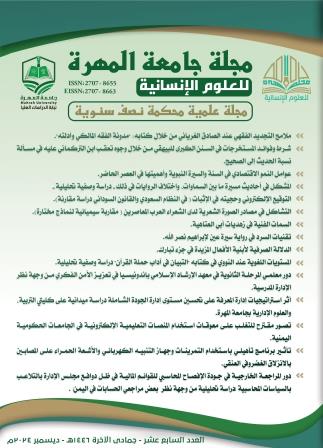The Abstruseness with the Hadiths about the Journey between the Heavens, and the Difference in the Narrations about that
"دراسة وصفية تحليلية"
DOI:
https://doi.org/10.71311/.v5i2.156Keywords:
heavens, journey, narratives, differences, sayingsAbstract
The research deals with the different narrations about a journey between the heavens, and studies the texts contained in that with a hadith doctrinal study. In his research, the researcher followed the descriptive, inductive, and analytical method, and concluded that the problematic texts are: every legal text; Its meaning is closed and hidden, or it appears to contradict another legal text. From a Qur’anic verse, an established Sunnah, or the illusion of an opposition considered to be: consensus, analogy, a comprehensive and established legal rule, a linguistic origin, a scientific fact, sense, or reason. The paths of the scholars in clarifying the problem are: They take the apparent meaning of the texts of the Qur’an and Sunnah, refer the similar texts to the decisive ones, give precedence to the Prophet’s interpretation of the texts over others, take the sayings of the Companions in matters about which there is no room for opinion, take into account the multiplicity of situations and occasions when an apparent contradiction occurs, and look into the matter. Arabic language. The most correct opinion, and God knows best, regarding the differences in narratives regarding the journey between the heavens is to say that the number is for multiplication because it is the evidence that is gathered together, and it agrees with the words of contemporary astronomers.
Downloads

Downloads
Published
How to Cite
Issue
Section
License
Copyright and Licensing
copyright is retained by the authors. Articles are licensed under an open access Creative Commons CC BY 4.0 license, meaning that anyone may download and read the paper for free. In addition, the article may be reused and quoted provided that the original published version is cited. These conditions allow for maximum use and exposure of the work.

